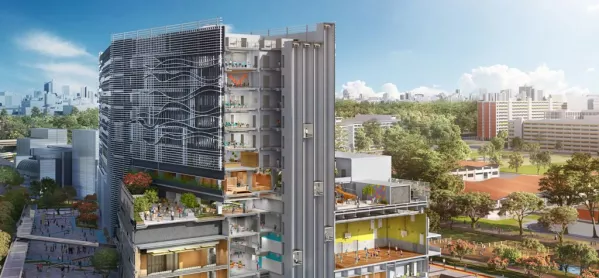- Home
- 4 ways the pandemic might reshape school design
4 ways the pandemic might reshape school design

The global pandemic has given everyone a chance to pause; to reflect on what we do and how we do it.
Social distancing, staggered classes, a blend of online and in-school teaching may all mean that schools of the future look and feel very different to those we know now, not just in the short term but for the medium and long term.
As an architect who has designed and overseen the building and operation of school projects in the UK, Middle East and Asia, I believe there’s also a huge opportunity to rethink what a school is and how we can improve the school experience for all.
Will the coronavirus change the design of schools?
So, what could our future schools look like?
1. They will be diverse and flexible
Open-plan schooling is not a new idea - it just got a bad reputation in some places, for good reason.
The acoustics weren’t considered well, but, most importantly, we know it has to be driven by the teachers and leadership.
Imagine breaking down all the walls in your school - literally. Then collaboratively consider a range of settings to suit a blended learning cycle.
You’ll be left with an open-plan hub, with space for targeted activity zones around the outside, including break-in rooms for lab, design or food tech work.
After being introduced to a topic by the teacher, students can find or make their own space to work in, while those needing help can be taken to a setting that nurtures the best possible results.
Small design interventions create resilient loose-fit buildings that suit both open-plan environments, where project-based learning thrives, and traditional class bases.
At Nexus International School (Singapore), we started with a standard series of six 65 square metre classroom bays per year group.
In most schools you would have a double row of central columns that are too narrow to accommodate a space for a large group. By moving them out slightly (not making the space bigger), we created a column-free area in the middle for our hubs.
This larger central area for self-directed learning and circulation combined could also remove pinch points to help maintain socially distanced “bubbles”.
2. They may be taller and more intelligent
Across the world, population density rises and constraints on urban sprawl put pressure on our “brownfield” land. So schools may have to go up, not out.
Nexus International School (Singapore) is built on a slice of land between an expressway and the Pelton Canal.
The tight site resulted in a “vertical campus”: with younger years at lower floors through to post 16 at the top. Despite a footprint of just 8,000 square metres - much less than a typical school of the same 50,000 square metres total area - it still features a swimming pool, sports field, two sports halls, a theatre, library and an outdoor play space.
Is it possible to maintain social distancing in a vertical school? By grouping years in hubs and staggering movement between bubbles (there is no school bell), it could be managed simply and intelligently through controlled stair and lift core access.
The school opened in January before having to close again due to the pandemic, but intelligent flexible use and design means that it was open and back in action from early June.
3. They will be flipped and distributed
The requirements of social distancing have shown, glaringly, that most schools are too small to reopen fully.
If the blended learning many schools have accelerated recently becomes permanent, we could reduce class sizes. But schools still need to respond by providing a range of different spaces.
Lessons learned in Asia reveal the flipped classroom is here to stay: a place where the “instructional” content is delivered online, and classroom time is focused on understanding the content through collaborative discussion and project-based learning.
A flipped school could offer shift entries or a rotation of smaller “bubbles” in school. For younger years, this is reliant on students being virtually engaged, while located physically in alternative workspaces potentially distributed around our community.
Better, more flexible performing arts and sports facilities would also provide parents and carers with support in a post-Covid future.
4. They will be woven into our communities
At Nexus, members of the public use its café and a range of facilities out of hours, made possible by a layered security and entry system.
For a post-pandemic future that redefines “the office”, the Nexus café and parents’ co-working areas bring another vision for our towns and cities.
Perhaps the future school will be a community with varied spaces for smaller groups and one-on-one spaces. Places able to act as flexible workplaces “distributed” through our towns and cities for those unable to use their home for the blended future that may await us - in school and at work.
The future school is not a model, it is a series of models. Maybe they don’t look like schools, but we don’t know what the future will look like either.
We do know that the challenge should be met with positive change.
Harry Hoodless BA (Hons) BArch MA ARB RIBA is director and head of education at architecture firm Broadway Malyan
Keep reading for just £1 per month
You've reached your limit of free articles this month. Subscribe for £1 per month for three months and get:
- Unlimited access to all Tes magazine content
- Exclusive subscriber-only stories
- Award-winning email newsletters